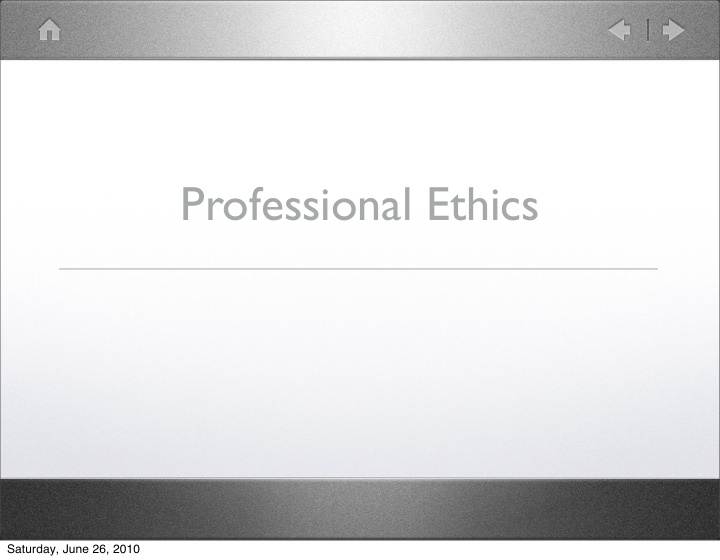



Professional Ethics Saturday, June 26, 2010
Overview • Introduction • Is software engineering a profession? • Software engineering code of ethics • Ethical analysis of the code • Case studies • Whistleblowing Saturday, June 26, 2010
Is Software Engineering a Profession? • Characteristics of a profession • Lawyers • Certified Public Accountants • Software Engineers Saturday, June 26, 2010
Profession • Profession (informal) • High level of education • Practical experience • Decisions have impact • We pay professionals well • Doctors, Lawyers • We expect professionals to act for public good Saturday, June 26, 2010
Characteristics of a Profession • Initial professional education • Education accreditation • Skills development, internship • Certification and Licensing • Professional development • Code of ethics • Professional society Saturday, June 26, 2010
Software Engineers • Certification and licensing not needed • Without these, other characteristics are irrelevant • No college education needed • No apprenticeship needed • No membership in professional society needed • No continuing education needed • Software engineers have ability to harm/help public Saturday, June 26, 2010
Code of Ethics • Statement of principles for guiding behavior within a domain of expertise, profession. • One motivation is to provide a professional structure for software engineers Saturday, June 26, 2010
ACM Software Engineering Code of Ethics • Preamble • Principles • Obligations Saturday, June 26, 2010
Preamble • Software engineers have opportunities to do good or do harm • Software engineers should be committed to do good • Eight principles identify key ethical relationships and obligations within these relationship • Code should be seen as a whole, not a collection of parts • Concern for the public interest is paramount Saturday, June 26, 2010
Preamble • No mechanical process for determining if an action is right or wrong • Should not take an overly legalistic view of the Code • If Code doesn’t forbid something, that doesn’t mean it is morally acceptable • Code reflects principles drawn from multiple ethical theories, including virtue ethics Saturday, June 26, 2010
ACM Code Principle Relationships • Public, Client/Employer • Product, Judgment • Management, Profession • Colleagues, Self Saturday, June 26, 2010
ACM Clauses • Under each Principle • a series of clauses • Clauses express ethical directions for that principle area Saturday, June 26, 2010
How to Use the Code • Decide what are key relations at issue • Consider principles to find those most related • Search clauses for those most relevant • Determine whether proposed action is consistent or inconsistent with clauses • Weigh countervailing arguments. Saturday, June 26, 2010
Case Studies • Software recommendation • Anti-worm Saturday, June 26, 2010
Software Recommendation • Sam Shaw asks for free advice on LAN security. • Prof. Smith answers questions and recommends top-ranked package. Saturday, June 26, 2010
Software • Prof. Smith does not disclose • She has financial interest in company producing top-ranked package. • Another package was given a “best buy” rating. • Did Prof. Smith do anything wrong? Saturday, June 26, 2010
Analysis • Most relevant directives • Disclose information others ought to know. • Share your knowledge, expertise, and values. • Relevant ACM Clauses • 1.08, 6.02: Prof. Smith freely gave valuable information • 4.05, 6.05: Prof. Smith did not reveal conflict of interest Saturday, June 26, 2010
Anti-Worm Scenario • Internet plagued by new worm that exploits hole in popular operating system. • Tim Smart creates anti-worm that exploits same security hole. • Tim’s anti-worm fixes PCs it infects. It also uses these PCs as launch pad to reach new PCs. • Tim launches anti-worm, taking pains to keep it from being traced back to him. • The anti-worm quickly spreads through Internet, infecting millions of computers Saturday, June 26, 2010
Ethical Analysis • Most relevant directives • Continually improve your abilities. • Share your knowledge, expertise, and values. • Respect the rights of others. • Take responsibility for your actions and inactions. Saturday, June 26, 2010
Analysis • Most relevant ACM clauses: • 1.08: The worm was free, but cost system administrators time. • 2.03: The anti-worm entered computers without permission of their owners. • 8.01, 8.02, 8.06: Tim improved his knowledge and skills by creating the anti-worm. Saturday, June 26, 2010
Example • You work for a health system software company creating a nurses assistant that will advise nurses on emergency responses. • There are several types of relatively rare situations that your new system can not handle. It would cost the company a lot of money to hire consultants to complete these. • Your company will release the product soon, claiming it is the first, complete product. Saturday, June 26, 2010
Restating Code Principles • Be impartial. • Disclose information that others ought to know. • Respect the rights of others. • Treat others justly. Saturday, June 26, 2010
Restating Principles • Take responsibility for your actions and inactions. • Take responsibility for the actions of those you supervise. • Maintain your integrity. • Continually improve your abilities. • Share your knowledge, expertise, and values. Saturday, June 26, 2010
International Perspectives • What can be added to the code to make it reflect concern for international differences and respect? Saturday, June 26, 2010
Recommend
More recommend